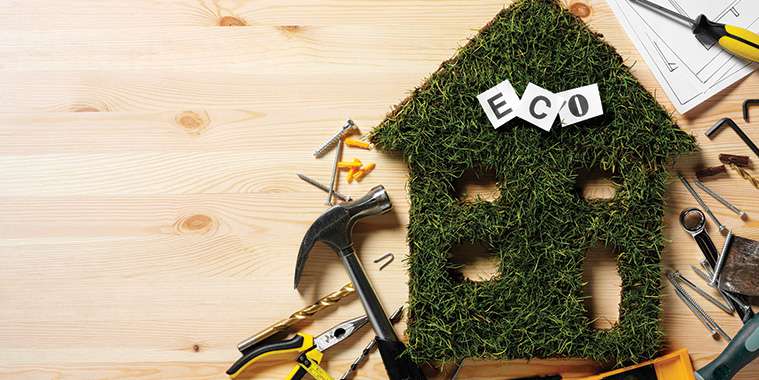We all know renovating isn’t easy, but doing it in an eco-friendly way can be an extra challenge. To celebrate Earth Day (April 22) we’re exploring a few ways to make your next home renovation environmentally sound. Here are five innovative ways to renovate more sustainably:
1. Something old, something new
Before you start your renovation, stop at your local Habitat for Humanity ReStore. There are more than 100 stores in Canada and 1,000 worldwide creating a huge double impact through social innovation. ReStore accepts donations and resells both new and used building materials, furniture and appliances that in turn, helps fund local Habitat for Humanity home construction projects. You might score the rain shower head or vanity that you’ve been looking at online for half the price. Once your reno begins, consider these eco-conscious tips to help soften the environmental impact of your project. If you’re patient and determined, garage sales, auctions, flea markets and antique fairs can reveal unexpected finds that will give your reno an original twist.
2. Get smart
Tackling your kitchen or laundry room? Maybe it’s time to upgrade a few inefficient appliances. Some libraries carry ‘Kill a Watt’ meters that can be borrowed, just like a book. The meter is plugged in and indicates how much energy your home appliances are using. Energy efficient refrigerators are now being designed with tinted glass panel doors. Knock twice and you can reveal what’s inside without letting the cold air escape. Curious about the appliances in the rest of your house and what they’re consuming? Check out this helpful usage chart to see if they get a green seal of approval or not. Low-flow showerheads, low-flush toilets and water saving faucets will dramatically reduce water consumption, and, money down the drain! Similarly, high efficiency washers and dryers will plug you into savings and a more ethical load. Better yet, kick it old school and take advantage of solar power and the wind with a clothesline!
3. Prepare to be floored
For a genuine “greenovation,” investigate unusual reclaimed flooring solutions—like bowling alley maple or heartwood pine. Sold in lengths of up to 14 feet, repurposing the former lanes with foul lines, target dots and arrows intact could be right up your eco-friendly (bowling) alley. For a more intensive DIY project, consider a copper penny floor. You will need about 278 pennies per square foot, but it should be easy to find friends willing to donate the discontinued coins to your cause!
There are several flooring options available to consumers today. For pet owners and parents, the search for non-toxic, allergen-free options can be even greater. Look for natural slate, void of a chemical sealant, or consider non-toxic VOC-free polished concrete. Natural undyed wool carpets are made from a renewable resource and are biodegradable too.
4. Paint it green
Low or zero-VOC paints have been growing in popularity because they eliminate the headache-inducing “new paint smell.” The decrease in off-gas is thanks to reduced volatile organic compounds (VOC), the culprits responsible for irritated eyes, asthma and nausea. Companies like Blue Moose Recycled Paint divert unwanted paint returned to Household Hazardous Waste Depots. This paint would otherwise be destined for toxic incineration or landfill sites. The recycled brand name paints are pre-tinted and re-manufactured.
Plant and mineral-based paints are made with natural ingredients like clay, citrus oils, plant dyes, beeswax and milk proteins. Milk paints are also environmentally friendly as they are non-toxic, biodegradable, non-flammable and antibacterial.
5. Hip hemp hooray
Hemp crops are attractive because they require no fertilizer or pesticides and need little water. The manufacturing process is dramatically less demanding than producing polyurethane insulation which is not recyclable or reusable like hemp. A hemp wool panel (with a R10 value) requires 3.4 kWh of energy to produce, while cellulose eats up 5.5 kWh and polyurethane a staggering 48.4 kWh. The non-toxic insulation can even be applied without gloves. While it can cost twice as much as traditional fibreglass installation ($1.80 per square foot for 3 ½-inch panels, not including shipping), there are distinct advantages to choosing hemp insulation–if it gets wet, it can be removed, dried out and re-installed. And, it’s biodegradable to boot. Currently there are only two companies producing the insulation in North America. Despite its equivalent thermal performance to mineral or cellulose products, hemp insulation can’t be installed in any standard known in the National Code 2015. However, a Quebec company has initiated the process of bringing their product to code after watching the popularity of bio-based insulation use surge in Europe.
‘Hempcrete’ is being praised for its healthy, natural quality. The bio-composite is comprised of the woody core (known as the “hurd” or “shiv”) of the hemp plant, blended with a lime-based binder. Hempcrete blocks will actually float in water which explains why they are used as insulating infill versus for structural purposes.
— Realtor.ca



